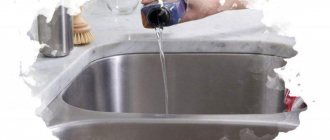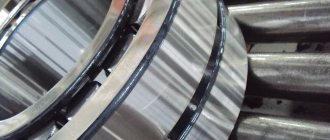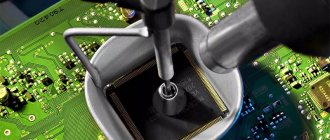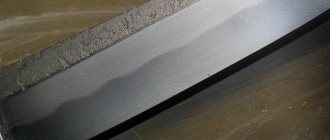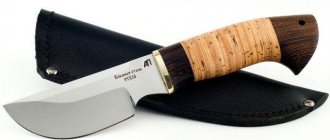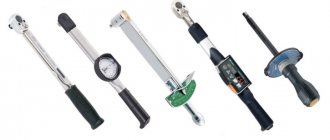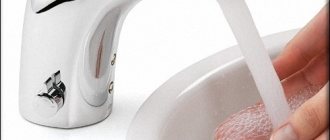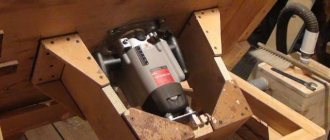Most car owners carry out repair and restoration work on their car in their garage, without turning to a car service center for help from specialists. There are currently a huge number of different devices and tools on the market; the process does not require unnecessary maintenance costs. However, one of the most essential tools is a torque wrench - a wrench with a built-in torque gauge. Such a tool performs the function of tightening fasteners and threaded connections, maintaining precise parameters, preventing overtightening, as well as thread breakage. In the article below we will look at the rating of the best torque wrenches, study their reviews and characteristics. Happy choosing!
Description of the device and principle of its operation
A torque wrench is a type of ordinary wrench. Its peculiarity and main difference is a special built-in device - a dynamometer. It is very useful when tightening bolts where a good threaded connection is required.
Torque wrench, appearance
Torque wrenches are used in many different industries, such as automotive, construction and mechanical repair. Bolts are frequently tightened in these areas. For example, in a car, you can tighten the cylinder head or other connections in the engine, but it is important not to damage or strip the threads. In this case, a dynamometer device is indispensable.
A torque wrench makes it possible to select the desired response value and not be afraid of possible damage to equipment during operation.
The main types of work in which devices are often used:
- Tightening of threaded connections in electrical installations.
- Tightening of bolted joints in the vehicle chassis or engine.
- Tightening of threaded connections of water and gas hoses.
- Removing and installing car rims on trucks and cars.
- Other works.
Various manufacturers offer all kinds of key devices. Most often, the differences are small and depend on the specific functional features of the application.
The basic package of a wrench with a dynamometer includes:
- housing and spring;
- adjustment handle;
- ratchet-type attachment that can be removed;
- locking pin for the nozzle;
- measuring scale;
- lock of the selected trigger force.
These are the main details. This metric tool is sold assembled.
In any type of work, a very important point is precisely the exact tightening torque of the bolt. If everything is done correctly, the connection is designed to withstand various changes in temperature, load and pressure. The connection is made in such a way that it can respond to changes in conditions and adapt within various limits.
If it is too tight or too tight, unpleasant consequences can occur. To avoid them, a wrench with a dynamometer was invented. You can find out the value of such a parameter as the tightening torque in the instructions for various types of equipment. This value must be indicated there.
You need to know the main types of torque wrenches.
Its second name is often found - switch. It has a standard dynamometer principle of operation and can indicate the amount of force that is applied when performing a certain action.
Scale torque wrench
It has a simple design consisting of the following elements:
- frame;
- dynamometer with dial indicator.
When working with such a wrench, it is important to monitor the tightening torque so as not to overtighten or, conversely, not tighten the thread.
Other negative aspects include the lack of a ratchet. In this regard, it becomes impossible to use the device in places with difficult accessibility, for example, under the hood of a car.
However, the scale device also has its positive sides. They are mainly due to the fact that it is made from a single piece of hardened steel and has:
- high strength, durability and reliability;
- low cost;
- ability to work with a large number of different connections.
Limit
Sometimes you can come across a second name for the device - click. Included in the top list of the most popular types of keys in various industries. As a result of its use, high accuracy can be obtained. It is convenient to use, and its price is quite low.
Snap torque wrench
To get started, you only need to set the required value, upon reaching which a click will occur. Having heard it, you need to complete the work. A very simple and convenient principle.
It consists of a handle on which there are two scales and a ratchet, which has a connecting square for the socket head.
The force is easy to set; to do this, you need to select the required value on the scale and turn the handle to the zero mark. After this, add one by one by scrolling the horizontal scale until you get the required number.
Key with digital indicator
This is the most advanced device at the moment. It shows maximum accuracy with an error of up to one percent. It is also the most expensive type of device on the market. This is due to the wide capabilities and large number of functions performed.
A design feature can be called a digital screen that displays all the indicators necessary for work.
Digital key
Peculiarities:
- two-component handle;
- vibration signal informing that maximum effort has been achieved;
- a display that displays all the necessary indicators;
- an audible signal indicating that the set torque has been reached;
- the housing on which all the parts are installed;
- set of replaceable nozzles.
There is a so-called adapter key, which has a mechanical drive. It is connected to a ratchet. This is a very versatile device, it can work with a preset value and display the current amount of force applied when tightening.
How to use a torque wrench correctly
To avoid damaging the tool, tightening should not be done after a click. In addition, do not throw, knock, unscrew fasteners or disassemble, and should be protected from moisture. Extending the service life is possible with careful handling of the torque wrench. At the moment of tightening, it is necessary to withstand torque, that is, the applied force, which depends on the friction on the supporting surface of the nut and in the thread. Since the friction force values fluctuate significantly, the bolts may also be loaded differently, although they were tightened with the same torque. To use a torque wrench correctly, you must:
- Determine the optimal tightening torque from the technical documentation.
- check the calibration of the key. Please note that sometimes the scale is expressed in different units of measurement.
- adjust the key, setting the required tightening torque and fix it on the tool at the desired mark. If necessary, you need to convert the tightening torque to the desired measurement system. If the manufacturer specifies a range rather than a specific reading, an intermediate number may be used. For example, if the specified range is from 8 to 11 Nm, you can select the number 9. It is convenient to use a torque wrench with a locking function, which allows you to not worry about accidentally changing the set position.
- install the fastening elements in the appropriate position and attach them. Of course, all connections must be clean and dry, unless lubrication of fastener elements is mentioned. If necessary, the manufacturer will indicate the need to use a locking agent.
- tighten the connection elements in the prescribed sequence to the required torque. As a rule, fastening elements with a larger thread diameter are tightened first.
- check how the tightening was done.
- Unlock and remove settings. The tool must not be left in a fixed position.
Some manufacturers indicate bolt tightening values in degrees. Typically this value is applied after a certain tightening value. In such cases, you can use a protractor or attach a degree wheel to the socket.
Torque wrench: which one to choose
It is necessary to be guided by the various features of the work that needs to be performed. If the work is very simple and does not require operations in hard-to-reach places, then a simple scale device is ideal. It is very durable, has a simple layout and allows you to carry out any action.
If the functionality of the scale device is not enough, the work can take place in hard-to-reach places and high accuracy is required, then you need to choose between digital and limit keys. A digital one will cost a little more, and its functionality is not always necessary. In most cases, a simple limit key is sufficient.
If it is necessary to maintain high accuracy and minimal error, you must choose a digital device.
Comparison of popular models and manufacturers
Among the main and most popular torque wrench production companies are the following:
- Berger. Developed and manufactured in Germany. It has high reliability, strength and durability. If we are guided by considerations of price and quality, then the company’s products are the most optimal.
- ALCA. The manufacturer of keys of this brand is the famous company Heiner from Germany. Another brand known for its quality, which produces products in the mid-price category.
- Gross. Also a German company specializing in the production of modern and reliable tools. Gross digital devices are rightfully considered one of the best in the world.
Berger model
Features of use
Over the entire existence of such keys, basic rules have been identified, subject to which their high-quality and durable use is possible:
- To avoid errors, do not tighten the thread after it clicks.
- The maximum torque must not be exceeded.
- It is advisable not to drop the key during operation.
- The device must be kept clean.
- It is necessary to constantly calibrate the key to reduce the likelihood of errors.
- The spring should be loosened before storing.
- Do not store in a damp place or at high temperatures.
Knowing the operating principles and devices of various types of torque wrenches, you can choose the most suitable and high-quality tool. For most motorists, a simple dial key will be sufficient.
Which torque wrench is best to buy for a car? Selecting a company and model
- ✅ Contents of the article:
- 1. Main types of torque wrenches
- 2. Review of 2021 torque wrench models
- 3. Review results - Which company and model is better?
- 4. Useful information on torque wrenches
A torque wrench for a car is a special tool for tightening threaded connections to a specified torque (force). The tightening torque is controlled by a special mechanism inside the product body; depending on the type of special tool, it may differ. In modern cars, components are regulated by the requirements for tightening threads when assembling mechanisms; reliability, safety in operation, as well as the service life of parts and the accuracy of mating elements depend on this. A torque wrench is a useful tool for a car that everyone must have. When choosing and purchasing, car mechanics and car enthusiasts have questions about the company and model, so this article reveals the following:
- the best types of car keys, their operating principle and design;
- which wrench is better and how to specifically choose a tool for a car;
- what to look for when purchasing;
- which manufacturers to focus on, choosing the best ones based on review;
- what are the prices in 2021.
In the previous article, which talked about the tightening torque of the front hub bearing, we briefly talked about the types of torque wrenches. Here we will take a closer look at the device and principle of operation, review the best torque wrenches for a car and select options for purchase.
In what sequence should you tighten?
A device with several fasteners at once requires special handling, otherwise surface deformation is possible. Therefore, it is necessary to tighten all the nuts evenly. This should especially be observed in connections that are subject to high compression loads, in particular the cylinder block. Some manufacturers indicate the required sequence. In the absence of such information, tightening the nuts with a torque wrench must be done from the center in a crosswise manner. First, the bolts are tightened by hand, and then a tool is used until the tightening torque is obtained. Consequently, reliable and uniform fixation of the device is ensured and surface deformation is prevented. Important connections are usually tightened with a torque wrench in several stages.
Torque wrench for a car - which one is better in design and execution?
Hand and mechanic tools, including torque wrenches for cars, are widely represented in retail outlets. These products are divided into 4-5 types and differ: in design, design, operating principle. In this review, we will look at four types of torque wrenches from four manufacturers, and then determine which one is best to choose for car repairs.
Limit type adjustable torque wrench
The limit or click type is a common type of torque wrench. Functionality and affordability are the main qualities. They work on the principle of pre-setting the torque value. After reaching the set value, the mechanism is activated, clicks are heard, and then the key stops transmitting torque to the head. The design is a type of ratchet to which a square attachment is attached and fixed with a switch.
The accuracy error of such a key ranges from 3-5%; more precise keys are also sold, but their cost is higher. When choosing a torque wrench for a car, pay attention to the torque limit (interval) , so before purchasing, be guided by your needs. Study the regulated tightening torques of the car's threaded connections. The average range of min values varies from 0.5 -15 NM, max 3 - 100 NM and more.
Among the disadvantages of the device, we note the fact that if there is no work experience, then when the click mechanism is triggered, the thread will be overtightened. The adjustment also gets lost after several operations, so you have to keep an eye on this.
Pointer torque wrenches
A torque wrench with a dial indicator that shows the amount of force applied works on the principle of a dynamometer. The dynamometer device is built into the body, and the arrow and indicator are located on top of the device. The square for attaching heads and attachments is located on the top. The disadvantage of the product is that the required force has to be captured, therefore the accuracy of the device is lower than that of other types of special tools. The only tightening limiter is the pointer stopping when the required amount of applied force is reached. This is not the best option for operating a car; switches are more often used in other industries. Pros of this product:
- Not high cost due to the design.
- Increased strength and reliability, as the tool is made of solid and hardened steel.
- The working interval is limited only by the scale (0-300 N*M).
Digital torque wrench
Instruments with digital display are expensive, but are better and more accurate due to useful additions:
- built-in memory;
- variety in setting;
- connection to a computer and calibration;
- date, time, car make;
- number of key uses;
- vibration or sound signal during operation.
The design of the digital tightening device is shown in the photo. The test sample consists of a standard housing, a working part with a connecting square. A rigid rod with a mechanical device inside is needed to determine the moment, and there is also a connecting element-sensor inside for transmitting data to a digital display.
Torque adapter key
An adapter-dynamometer is an electronic device with a mechanical drive that is attached to the ratchet; a head or other attachment is inserted onto the adapter. Depending on the configuration, the set contains additional adapters. Sets with several adapters are also sold, which differ in torque intervals. The adapter has a digital display, as well as buttons for making settings. The operating principle is similar to the electronic product described above. There are batteries inside, the body is made of durable plastic. The main advantage of the adapter is its versatility. The cost is comparable to the average mechanical torque wrench. The adapter is popular in 2021 and will be one of the best choices when purchasing, it will simplify car maintenance.
Rules for working with the key
Using a torque wrench is quite simple. However, if used improperly, the tool can be damaged. To prevent damage, you must adhere to several rules. So, tightening is done as follows:
- It is forbidden to re-tighten after a click, especially at low torque;
- after a long period of inactivity of the tool, in order to distribute the lubricant evenly, it is necessary to start work with a low torque level;
- it is prohibited to turn the handle in the position when the lock nut is tightened;
- When cleaning, do not use cleaners so as not to damage the factory lubricant;
- It is necessary to store keys with a low torque value;
- Do not lower or raise the handle below or above the permissible value.
Working with a torque wrench helps you accurately calculate the applied force. Although it is important to take into account the fact that tightening implies the occurrence of a friction force between fasteners, therefore, this parameter directly depends on it.
Which brand of torque wrench is better and how to choose a torque wrench for your car
The torque wrench is selected based on your needs. For servicing a car in a garage, a mechanical one with a limiter or a pointer is suitable; for a car service, a digital option is being considered. The review of the best torque wrenches presented in the article will help you decide on the choice of a specific type and manufacturer. You can decide on the best torque wrench by studying further material in the article. The models in the review were tested directly when tightening the threaded connections of vehicle components, with min and max forces. To summarize, we choose the best torque wrench for the car.
What types of torque wrenches are there, and which one to choose for your car?
Every car requires periodic maintenance, repair and preventive maintenance. Moreover, many vehicle owners prefer to do it all themselves.
The machine contains a number of complex devices that are subject to increased requirements in terms of their assembly, disassembly and restoration. Fitting the part, tightening the fasteners correctly and eliminating the possibility of loosening is extremely important in such situations.
Not everything can be done by eye or approximately, guided by your own feelings. Sometimes you need to follow strict rules, make certain efforts, without exceeding or decreasing these values. This is where a tool like a torque wrench comes to the fore.
Torque wrenches come in several types. They differ in design and degree of error, and are intended for use in garage and professional environments. Therefore, motorists are interested in which key it is better to choose.
Many mechanisms that are used in the assembly of vehicles require special conditions during repair and maintenance. The same threaded connections that are used in vehicle structures and systems require a measured degree of tightening.
To tighten the fastener with the required force, the help of a torque wrench is required. This is a special device designed to tighten bolts and nuts by applying measured force. To be more precise, we are talking about the moment of force, the measuring unit of which is the Newton meter (Nm).
By using this key, you can adhere to strict rules on the quality of assembly of components, connections and mechanisms. If the contact between the parts is not strong enough, leakage of working fluid or gas may occur. When the fastenings are loosened, the operation of the mechanisms is disrupted, the components can become loose, break and finally fail.
But insufficient effort is no less dangerous than excess. If the permissible tightening standards are exceeded, the connecting elements may burst, collapse, or this may lead to deformation of the fixed element. Threads break, heads break, fasteners become deformed. Eliminating such consequences is difficult and expensive.
A torque wrench is rightly considered a universal tool and a wonderful assistant for every car owner. It has different attachments, which allows you to work with all kinds of components, systems and mechanisms.
The torque wrench has an output square. A suitable nozzle in the form of a head or socket is mounted on it. Slip-on, nut or horn attachments are already installed on it. Don't forget about torque wrenches that have a screwdriver function. This tool is useful when repairing automotive electronics or highly fragile mechanisms.
One torque wrench, complemented by an assortment of attachments, allows you to perform a wide range of repair, restoration and maintenance work. This tool will come in handy during routine replacement of consumables, but will also become indispensable during complex repairs of a failed vehicle component.
Although the design of the keys may differ somewhat from each other, all types of this tool necessarily include a number of basic components. Therefore, we can say with confidence that the torque wrench consists of:
- removable attachment (aka ratchet);
- sockets for installing nozzles;
- retainer for nozzles;
- housings with a spring mechanism;
- measuring element or measurement scale;
- handles;
- torque clamp.
Using a torque wrench, the user can control the force he applies when tightening a particular element. Here, measuring devices are used, or a special lock is used, which, when a certain force is reached, stops the key from working. If you have reached the set value, the tool will rotate, and therefore you will not be able to tighten the fasteners more than the established norm.
Such a tool requires periodic checking of the accuracy of its operation. Experts recommend doing this after 5 thousand cycles of use, but at least once a year. Calibration is carried out on special machines by qualified specialists. You cannot calibrate a torque wrench yourself.
GOST
GOST 33530-2015 has been developed for installation tools intended for standardized tightening of threaded connections, namely for torque wrenches and screwdrivers.
Verification is carried out in accordance with the State System for Ensuring the Uniformity of Measurements GOST 8.541-86 clause 2.1.2.
Torque wrenches from WERA, NORGAU, KING TONY, Jonnesway (Johnsway) and Tohnichi are certified in Russia and included in the state register of measuring instruments, so they can be used at sites where high demands are placed on torque accuracy and work with the most critical threaded connections, provided that the verification period has not expired.
As a rule, branded “speakers” are of higher quality, they have high performance and small errors, which are stated in the instrument’s data sheet.
Also, the number of documents attached to the measuring instrument must include certificates.
Certificates
Although this tool is called a key, at its core it is a measuring device that must have the appropriate documents: a device passport with a mark from the metrology laboratory about verification, certificates, etc.
A calibration certificate, also known as a verification certificate, indicates that the instrument has been tested in laboratory conditions to determine the accuracy and error of the device.
The test is carried out using different tightening forces, as a result of which the real values are established.
Wrenches suitable for international use, including the EU region, must comply with the calibration procedures of ISO 6789, Type I, Class B.
Error
Manufacturers claim an error of 3-4% for high-quality branded torque wrenches, which indicates a fairly high accuracy of such devices.
The accuracy of some models of this instrument reaches 99%.
Calibration and verification
All measuring instruments included in the Russian Register must be verified within the time limits established by the standards; it is unacceptable to use them without verification.
By average standards, torque wrenches are required to be calibrated once a year or after every thousand operating cycles.
Important!
A tool that requires verification must be calibrated independently, and tampering with its design is prohibited.
At the same time, nothing prevents you from calibrating devices used in conditions where verification is not necessary.
Varieties
You definitely won’t be able to understand which torque wrench is best to choose for your car if you don’t understand their varieties.
In total, manufacturers offer several options for keys, which differ in their operating principles and have varying degrees of error. Although it is worth noting right away that the maximum error can be no more than 8%. Therefore, even they are suitable for a number of jobs performed in a garage.
Depending on the design, a torque wrench can be used for quick connections, or to perform the most precise tightening of critical parts. Some models have a preset torque function. Others are not adjustable or can be adjusted based on the torque limit.
As a result, we can divide all the tools into:
To make it easier for you to choose the right torque wrench for your car, we will consider each of the presented types separately.
Electronic
Such tools are mainly used in professional service stations and service centers. These are the most expensive models with excellent error parameters. Here it is no more than 1%, which is considered an ideal result. No analogue is capable of this.
Electronic torque wrench
Electronic keys are equipped with liquid crystal indicators, which allows you to display information in the form of numbers on the display. When the force reaches the required values, a sound signal appears.
Whether to use electronic torque wrenches at home or not is a purely individual question. In terms of functionality and accuracy, they are significantly ahead of many competitors. But such advantages come at a high price. If you are ready to spend at least 12 thousand rubles on one tool to use it at home, no one will definitely dissuade you.
An undeniable advantage is that electronic devices control the force applied when tightening down to hundredths of a Newton meter. Therefore, with their help, the most accurate and complex work is carried out.
Switches
Using a pointer device, the user can monitor how much force is applied when tightening. Pointer-type mechanisms allow you to set the required tightening value. You need to control it yourself.
Pointer instruments have 2 options.
- Single arrow key. It shows the force being applied at a given moment.
- A tool with a pair of arrows. One arrow is designed to show the maximum value. The other is responsible for displaying the current Nm value.
Single-pointer instruments are also divided into measuring and indicator instruments. For indicator scales, the scale is presented in the form of a round dial, where the force is indicated by an arrow that rotates around an axis.
The measuring device has a scale with special divisions, which is located near the handle. The force parameters are indicated by a long arrow. When the fastening is tightened, the arrow begins to move towards the zero or starting value.
Both instruments have an extremely simple design. They are easy to use, although during operation you have to constantly monitor the indicators yourself.
Arrow torque wrench
The disadvantage of pointer torque wrenches is their error. Among all existing instruments, it is the highest here. Therefore, it is not recommended to use pointer devices when tightening especially important and demanding connections in terms of accuracy.
But they are cheap. Considering the fact that in garage conditions, car owners mainly carry out simple repair work, for them the capabilities of an arrow torque wrench are more than enough.
Quite often the choice falls on the open-end type of torque wrench for cars. Many craftsmen have such a device in their arsenal, since for many operations it is often not possible to choose a suitable coupling head, or the mount is located in a hard-to-reach place. Then an open-end wrench becomes an excellent solution for the current situation.
A distinctive feature of such torque wrenches is the presence of a socket where replaceable open-end attachments are installed. Open-end wrenches are very convenient when working in areas where access is limited or complicated by other vehicle parts.
Open-end torque wrench
It is worth noting that there are different open-end torque wrenches on the market. On some, you can use exclusively branded attachments from the manufacturer. But there are also universal models that allow the installation of attachments from different manufacturers.
As for the indication of tightening torque, arrow, digital, click and limit systems are used on open-end wrenches.
This type of key is suitable in situations where working conditions are especially difficult, and the technician does not have the ability to control digital or dial readings.
Snap torque wrenches are superior in versatility to all their competitors. Many motorists buy them because such tools allow them to perform a number of complex operations with their own hands, without the risk of overtightening or not fully tightening fasteners in hard-to-reach places.
The indication system is based on a click. When the tightening reaches the desired value, a click occurs. Moreover, it is felt by ear, but is also very expressively reflected on the hand. It won't be difficult to feel exactly when to stop.
Click dynamometer
Moreover, such instruments are distinguished by excellent sensitivity. The error in the values does not exceed 4%. And the price is more than adequate. This explains the popularity of click-type torque wrenches.
Marking and strength class of parts
The numerical designation of the strength parameter of a metric bolt is indicated on the head, and is presented in the form of two numbers separated by a dot, for example: 4.6, 5.8 and so on.
- The number before the dot indicates the nominal size of the ultimate tensile strength, is calculated as 1/100, and is measured in MPa. For example, if the product is marked as 9.2, then the value of the first number will be 9*100=900 MPa.
- The number after the point is the ultimate yield in relation to strength; after calculation, the number must be multiplied by 10, as indicated in the example: 1 * 8 * 10 = 80 MPa.
Read also: How to cut slate
Designation of the strength class of metric bolts
The yield strength represents the maximum load on the bolt structure. Elements that are made from stainless steel types are designated directly by the type of steel itself (A2, A4), and only after that the ultimate strength is indicated.
For example, A2-50. The value in such markings indicates 1/10 of the strength limit of carbon steel. At the same time, products for the manufacture of which carbon steel is used have a strength class of 2.
The strength designation for inch bolts is marked with notches on its head.
Designation of the strength class of inch bolts
